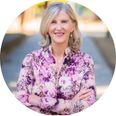Key Ingredients in Shaping My Scientific Journey
 Key Ingredients in Shaping My Scientific Journey
Key Ingredients in Shaping My Scientific Journey
Holly A. Ingraham, PhD, is the Herzstein Endowed Professor of Molecular Physiology at the University of California, San Francisco. The FASEB Excellence in Science Lifetime Achievement Award recognizes her pioneering work revealing crucial hormone-responsive nodes in the brain and gut that maintain metabolic, skeletal, and cognitive health in females.
Can you briefly discuss your background and what you do in your current role?
Ingraham: I trained as a graduate student and postdoctoral fellow at UCSD and the Salk Institute. For the last 30 years, UCSF has been my scientific home, where I am currently a professor in the Department of Cellular and Molecular Pharmacology and the Hertzstein Endowed Professor of Molecular Physiology. Over the last decade, I have had the privilege of directing one of the nation’s NIH-funded IRACDA training programs to build community and broaden opportunities for postdoctoral scholars seeking to join the academic research enterprise.
When did you decide to become a scientist? Were you inspired by someone (or something)?
Ingraham: I was inspired by my biology high school teacher, Mr. Jones, who introduced me to DNA and the genetic code. After that, I was hooked on understanding how things work in our bodies. My other inspiration comes from my great grandfather’s microscope, which came my way in the fifth grade. This microscope and my parents, who allowed me to explore nature freely and without pressure, were two key ingredients that helped shape me as a scientist.
Your nomination includes the research you’ve conducted and published. What drew you to this field of research? What do you wish to achieve with your research?
Ingraham: I have always been intrigued by the underlying mechanisms that drive sex differences in mammalian physiology. Knowing how hormones shape female physiology and behavior seemed like a fundamental key question if we were ever going to understand the basis for sex-bias diseases that afflict millions of women. Thus, rather than focusing on the role of hormones in cancer, which is where everyone else was headed, I decided to tackle this puzzle by asking simple, basic questions—how are physiological sex differences established, and how does hormone signaling in the brain and peripheral tissues drive homeostatic responses in the female life cycle?
What discovery are you most proud of and how did you feel when you made that discovery?
Ingraham: As I tell younger scientists, remarkable findings that turn your mind in new directions rarely occur. For me, they come along every decade. Each one of these discoveries came after multiple failed experiments and disappointments, which are the backbone of any scientific breakthrough. Currently, our group has defined new pathways that help explain how the female brain is able to mount sex-specific adaptive responses to maximize reproductive success and sustain progeny. I am most excited by the potential of our findings to impact women’s health, which has been historically underfunded and understudied.
The Excellence in Science Award also celebrates your contributions to the broader scientific community and your history of training students and postdoctoral fellows. What have you most enjoyed/found the most meaningful about such service?
Ingraham: Motivated by the missing elements of my career, my goal is to provide younger scientists with guidance and support to build confidence and success. That often means giving constructive but candid advice that will allow them to reach their goals. Watching them transform and thrive in any aspect of the biomedical research enterprise is a delight.
What does it mean to you to receive the Excellence in Science Award?
Ingraham: After looking at past awardees, I am truly honored to be on this list of remarkable women scientists. I am incredibly grateful that FASEB had the vision to create and sustain this prize for over 30 years.
What advice would you give to young women entering this field?
Ingraham: The demands on women, especially those who have young families, are enormous—which is why so many choose not to stay in academia. Collectively, our systems must recognize this vulnerable period and give young women the gift of time. Find your support system—mine was my spouse, who also happens to be a scientist. More importantly, I never say “Yes” an administrative request or a collaboration without carefully considering how this will impact my community and what I most love—doing science.